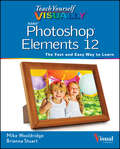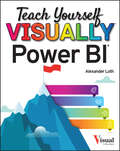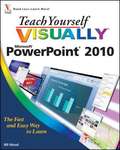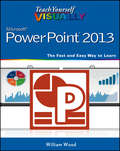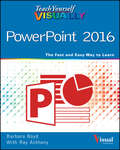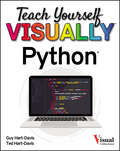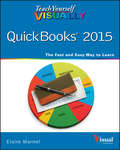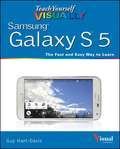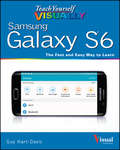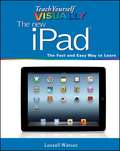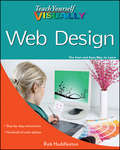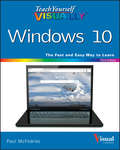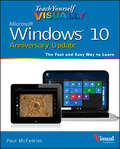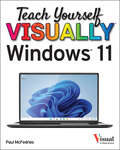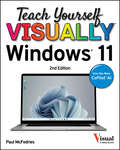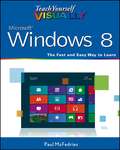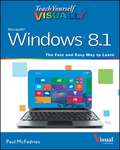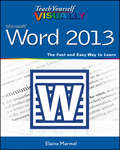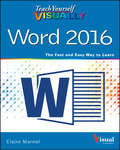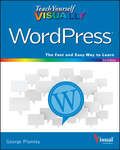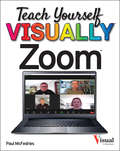- Table View
- List View
Teach Yourself VISUALLY Photoshop Elements 12 (Teach Yourself VISUALLY (Tech))
by Mike WooldridgeAre you a visual learner? Do you prefer instructions that show you how to do something — and skip the long-winded explanations? If so, then this book is for you. Open it up and you'll find clear, step-by-step screen shots that show you how to tackle more than 160 Photoshop Elements tasks. Each task-based spread covers a single technique, sure to help you get up and running on Photoshop Elements 12 in no time. You'll learn to: Use both the Organizer and Editor Import photos from various sources Enhance lighting and color Restore old photos and add effects Save, back up, and share photos Designed for visual learners Two-page lessons break big topics into bite-sized modules Succinct explanations walk you through step by step Full-color screen shots demonstrate each task Helpful sidebars offer practical tips and tricks
Teach Yourself VISUALLY Power BI (Teach Yourself VISUALLY (Tech))
by Alexander LothA comprehensive and fully visual guide to Microsoft Power BI Teach Yourself VISUALLY Power BI collects all the resources you need to master the everyday use of Microsoft's powerful data visualization software and delivers them in a single, easy-to-use volume. Fully illustrated, step-by-step instructions are combined with crystal-clear screenshots that walk you through the basic and advanced functions of Microsoft Power BI. Teach Yourself VISUALLY Power BI offers the best visual learning techniques with complete source material about the interface and substance of Power BI, as well as: Stepwise guidance on working with, transforming, and processing data sources Instructions for customizing data visualizations to create informative and presentation-ready charts and graphs Full-color, two-page tutorials on the more advanced features of Power BI, including app integrations and data access with DAX The fastest, easiest way for visual learners to get a handle on Microsoft Power BI, Teach Yourself VISUALLY Power BI is a can't-miss resource, loaded with useful tips for newbies and experts alike.
Teach Yourself VISUALLY PowerPoint 2010
by Bill WoodFast, easy way to get the very most out of PowerPoint 2010Present your work in style in a PowerPoint presentation using the tips and techniques in this visual guide to PowerPoint 2010. It covers the basics, as well as all the exciting new changes and additions in a series of easy-to-follow, full-color, two-page tutorials. Learn how to create slides, dress them up using templates and graphics, add sound and animation, and more. If you're looking for a practical, "show me, don't tell me" guide to PowerPoint 2010, this is the book for you.Helps you create presentations with greater impact using PowerPoint 2010, the latest generation of Microsoft's presentation software; PowerPoint 2010 is part of the new Microsoft Office 2010 suite of productsIntroduces PowerPoint 2010's new features, including the new Reading View, new transitions tab, and a new screenshot functionShows you how to create slides, dress them up with templates and graphics, add sound and animation, and present in a business or Internet settingFeatures easy-to-follow, full-color, two-page tutorialsAdd more power to your PowerPoint presentations with this practical guide.
Teach Yourself VISUALLY PowerPoint 2013 (Teach Yourself VISUALLY (Tech) #138)
by William WoodA straightforward, visual approach to learning the new PowerPoint 2013! PowerPoint 2013 boasts updated features and new possibilities; this highly visual tutorial provides step-by-step instructions to help you learn all the capabilities of PowerPoint 2013. It covers the basics, as well as all the exciting new changes and additions in a series of easy-to-follow, full-color, two-page tutorials. Learn how to create slides, dress them up using templates and graphics, add sound and animation, and more. This book is the ideal "show me, don't tell me" guide to PowerPoint 2013. Demonstrates how to create memorable and captivating presentations using PowerPoint 2013, the latest generation of Microsoft's presentation software Walks you through PowerPoint 2013's new features, including new wide-screen themes and variants, improved collaboration tools, and an enhanced Presenter View Shows you how to create slides, dress them up with templates and graphics, add sound and animation, and present in a business or Internet setting Features easy-to-follow, full-color, two-page tutorials With Teach Yourself VISUALLY PowerPoint 2013, you have the power to make a remarkable presentation!
Teach Yourself VISUALLY PowerPoint 2016 (Teach Yourself VISUALLY (Tech))
by Barbara BoydThe uncomplicated PowerPoint guide designed specifically for visual learners Are you a visual learner who wants to spend more time working on your presentations than trying to figure out how to create them? Teach Yourself Visually PowerPoint offers you an effortless approach to creating winning presentations with the latest version of PowerPoint. This accessible resource features visually rich tutorials and step-by-step instructions that will help you understand all of PowerPoint's capabilities—from the most basic to the most advanced. With Teach Yourself Visually PowerPoint, you'll learn how to create slides, dress them up using templates and graphics, add sound and animation, present in a business or Internet setting, and so much more. Covering the latest additions and changes in the new version of PowerPoint, a series of easy-to-follow, full-color tutorials helps you to quickly get up and running using PowerPoint like a pro! Highly visual tutorials and step-by-step screenshots make lessons easy to follow and understand Helps you learn the basic functions of PowerPoint—and beyond Walks you through PowerPoint's latest features Demonstrates how to create memorable and captivating presentations using PowerPoint Do you prefer instructions that show you how to do something—and skip the long-winded explanations? If so, Teach Yourself Visually PowerPoint is for you.
Teach Yourself VISUALLY Python (Teach Yourself VISUALLY (Tech))
by Guy Hart-Davis Ted Hart-DavisA simple, straightforward, and hands-on roadmap to the world of computer programming with Python Teach Yourself VISUALLY: Python is your personal guide to getting you started in programming. As one of the world's most popular—and most accessible—coding languages, Python is your gateway into the wide and wonderful world of computer science. This hands-on guide walks you through Python step by clearly illustrated step, from writing your very first Python code in a terminal window or the VS Code app through to creating your own lists, dictionaries, and custom classes. In the book, you’ll learn to: Install Python and the tools you need to work with it on Windows, macOS, and Linux Work with files and folders, manipulate text, and create powerful functions that do exactly what you want Write clean code that makes decisions effectively, repeats actions as needed, and handles any errors that occur A must-have resource for aspiring programmers starting from the very beginning, Teach Yourself VISUALLY: Python is also an indispensable handbook for programmers making a transition from another language.
Teach Yourself VISUALLY QuickBooks 2015
by Elaine MarmelThe visual way to master QuickBooks XIf you learn better by seeing rather than wading through confusing text, then this visual guide is for you! Teach Yourself Visually QuickBooks X gives you hundreds of succinctly captioned, step-by-step screenshots that reveal how to master QuickBooks X and get your business finances in working order. QuickBooks X is the world's most popular accounting software, but that doesn't mean it's easy to figure out on your own. In this great guide, you'll find tons of visual references that make it easy to navigate QuickBooks X. Learn how to store and process company names, addresses, and account information, track accounts payable, compile and integrate data, produce reports for tracking and analyzing financial data, and so much more--all with visual references that won't make you pull your hair out!Find out how to choose a company identity and set up your sales taxCut through the jargon and see how to edit paycheck information and track employees' time recordsCreate invoices and estimates with QuickBooks XFollow along with easy-to-decipher screenshots that make it clear how to pay bills online and print financial reportsIf you're a visual learner interested in getting your business finances in order, this see-as-you-go guide makes it easier to master QuickBooks X without the headache of trying to figure out hard-to-read text.
Teach Yourself VISUALLY Salesforce.com (Teach Yourself VISUALLY (Tech))
by Justin Davis Kristine CuringtonThe highly visual, step-by-step guide to getting the most out of Salesforce.com Teach Yourself VISUALLY Salesforce.com, 2nd Edition is your ideal guide to getting up to speed on the world's number-one on-demand customer relationship management (CRM) system. With full color screenshots and step-by-step instructions, this highly visual manual shows you everything you need to know to get the most out of Salesforce.com. You'll be walked through each step of the entire process, from choosing the right edition and customizing your service to capturing leads, inputting contacts, tracking correspondence, reviewing reports, and more. This updated edition covers the newest features and tools that make your business run more smoothly, so you can get up and running quickly. This book is your ultimate guide to optimizing Salesforce.com capabilities, helping you leverage your data into added value for your business. Choose the right Salesforce.com edition to suit your needs Master the latest and most helpful features Personalize your system for a tailor-made CRM solution Manage accounts, develop contacts, track inventory, and more
Teach Yourself VISUALLY Samsung Galaxy S 5
by Guy Hart-DavisThe visual guide to unlocking the full potential of the Samsung Galaxy S5 Teach Yourself VISUALLY Samsung Galaxy S5 is the comprehensive guide to everything your new phone has to offer. Clear, concise language and pages of screenshots make this resource easy to follow. With expert guidance written by a veteran technology author, you'll learn how to fully use the Galaxy S5's features and capabilities. All aspects of the device are covered, from initial setup to staying in touch, organizing your life, playing games, watching media, and more! The Samsung Galaxy S5 runs on an Android-based platform, giving you access to over 1 million apps and providing coverage by major carriers worldwide. The Galaxy S5 has added brand new features, such as iris recognition security. This Teach Yourself VISUALLY guide provides step-by-step guidance for getting the most out of your smartphone, laid out in a visually-rich style making it invaluable to those new to smartphone technology. Configure and get your phone set up just the way you want Text, e-mail, use social networking, and take pictures easily Access the Internet, maps, and navigate in a snap Download apps and sync your Galaxy S5 with other devices Your Galaxy S5 can streamline your life, and keep you organized and in touch. Teach Yourself VISUALLY Samsung Galaxy S5 is the new Galaxy owner's indispensible guide to getting up and running quickly.
Teach Yourself VISUALLY Samsung Galaxy S6
by Guy Hart-DavisYour visual guide to unlocking the full potential of the Samsung Galaxy Teach Yourself VISUALLY Samsung Galaxy is your step-by-step, visual guide to everything your new phone has to offer. With expert guidance from veteran technology author Guy Hart-Davis, it offers clear, concise instructions and pages of full-color screenshots that make it easy to learn how to fully utilize the Galaxy's latest features and capabilities from initial set-up to staying in touch, organizing your life, playing games, watching media, and more! Configure and get your phone set up just the way you want it Text, e-mail, use social networking, and take pictures easily Get access to the Internet, maps, and navigation in a snap Download apps and sync your Galaxy S6 with other devices Your new Samsung Galaxy can streamline your life and keep you organized — all with the touch of a finger. Make the most of the experience with Teach Yourself VISUALLY Samsung Galaxy!
Teach Yourself VISUALLY Search Engine Optimization (SEO)
by Rafiq ElmansyThe perfect guide to help visual learners maximize website discoverability Whether promoting yourself, your business, or your hobbies and interest, you want your website or blog to appear near the top when your customers search. Search engine optimization, or SEO, is increasingly essential to businesses. This full-color, step-by-step guide demonstrates key SEO concepts and practices in an easy-to-follow visual format. Learn how to set up your website and what to implement to help your business or product make a great showing in search results. Helps visual learners understand and practice important SEO concepts Uses full-color, step-by-step tasks to teach the elements of SEO Provides information you can quickly and easily implement to enhance your site's search engine rankings Demonstrates how to make your site attractive to casual web surfers as well as to the algorithms and spiders used by Google and other search engines Teach Yourself VISUALLY SEO will demystify search engine optimization, helping you boost search engine rankings and improve the visibility of your website.Note: Per the Penguin Policy 2.0 update, some of the tasks in Chapter 6 may present a risk to Google page rank. Please read the latest policy update from Google to know fully what will work best for increasing and maintaining Google Page Rank
Teach Yourself VISUALLY The new iPad
by Lonzell WatsonA new edition of a bestseller, fully updated on the latest features of the iPad! The evolution of the iPad continues to deliver amazing possibilities, which is exactly why this bestselling guide evolves right along with it! Fully updated with coverage on the latest generation of the iPad, this full-color, step-by-step guide is perfectly suited for anyone who is a visual learner and learns best by visual cues and a tactile interface. You'll learn to access and download books, apps, music, and video content as well as send photos and emails, sync with other devices and services, and confidently use the multi-touch display. Highlights how to connect to multimedia content, social networking, and the Internet Shows you how to upload more than half a million apps, including award-winning games and helpful productivity tools Helps you take advantage of the potential of the iPad with the featured visual tips and guidance If you've got the latest iPad, then you certainly need the latest version of Teach Yourself Visually iPad 2 to go with it!
Teach Yourself VISUALLY Web Design
by Rob HuddlestonThe mechanics of Web design made easy for visual learnersAn effective Web site combines good graphic design principles with a functional user interface. This colorful, step-by-step guide shows visual learners how to plan, develop, and publish a site, all with easy-to-follow lessons. Each task is illustrated with screen shots accompanied by numbered steps. You'll learn all the tools and techniques for creating great-looking Web sites that users will love.Good Web design incorporates basic graphic design principles as well as the techniques required to make a site easy to navigate and user-friendlyThose who learn best when someone shows them how will quickly get up to speed with the full-color screen shots and step-by-step illustrations in this visual guideCovers planning a site, creating eye-popping content with popular Adobe tools, building in functionality with HTML and CSS, testing the site, taking it live, and keeping it up to dateCompanion Web site features code and design examples for experimentationIf you find learning easier when someone shows you how to do something, you'll quickly learn to build Web sites with Teach Yourself VISUALLY Web Design.
Teach Yourself VISUALLY Windows 10 (Teach Yourself Visually (tech) Ser.)
by Paul McFedriesMaster Windows 10 by reading only one book Teach Yourself Visually Windows 10, 3rd Edition brings together all of the necessary resources to make you an expert in the use of the latest version of Windows. Using highly visual techniques to maximize learner retention and memory, Teach Yourself Visually Windows 10 will have you breezing through the most popular operating system in the world in no time. The book includes hundreds of step-by-step and illustrated sets of instructions to teach you both the basics and the complexities of Windows 10 operation. Lessons include: · Installing and repairing applications · System maintenance · Setting up password-protection · Downloading photos · Managing media files · And more Teach Yourself Visually Windows 10 combines the best of visual learning techniques with comprehensive source material about the interface and substance of Windows 10 to leave you with encyclopedic knowledge of the operating system. Perfect for beginners and intermediate users alike, this book will turn your Windows-using experience from a slow slog into a lighting-fast masterclass of efficiency.
Teach Yourself VISUALLY Windows 10 Anniversary Update
by Paul McFedriesThe ultimate visual learner's guide to Windows 10 Teach Yourself VISUALLY Windows 10 Anniversary Update is the quick and easy way to get up and running with Windows 10 and Windows 10 Update. From setting up to shutting down and everything in between, this book guides you through everything you need to know to start working with Windows 10. Learn how to customize Widows 10, pin an app to the Start menu, work with files and digital media, customize the interface, optimize performance, set up email, go online, and so much more. Two-page spreads, detailed instruction, and expert content walk you through more than 150 Windows tasks. Coverage includes the Windows 10 release, along with the newest features of the Windows 10 Anniversary Update. This is your visual guide to learning what you can do with Windows 10 and Windows 10 Anniversary Update. Find your way around Windows 10 with full-color screen shots Install programs, set up user accounts, play music and videos, and more Learn basic maintenance that keeps your system running smoothly Set up password protection and troubleshoot basic issues quickly
Teach Yourself VISUALLY Windows 11 (Teach Yourself VISUALLY (Tech))
by Paul McFedriesEverything you need to know about Windows 11 in a single, visual book Teach Yourself VISUALLY Windows 11 collects all the resources you need to master the day-to-day use of Microsoft’s new operating system and delivers them in a single resource. Fully illustrated, step-by-step instructions are combined with crystal-clear screenshots to walk you through the basic and advanced functions of Windows 11. Teach Yourself VISUALLY Windows 11 offers the best visual learning techniques with comprehensive source material about the interface and substance of Windows 11, as well as: Stepwise guidance on working with files, digital pictures, and media Instructions for customizing Windows 11 and sharing your computer with family members Tutorials on installing and repairing applications, system maintenance, and computer security The fastest, easiest way for visual learners to get a grip on Windows 11, Teach Yourself VISUALLY Windows 11 is the best way to go from newbie to expert in no time at all.
Teach Yourself VISUALLY Windows 11 (Teach Yourself VISUALLY (Tech))
by Paul McFedriesA fully illustrated, up-to-date, and start-to-finish guide to using Windows 11 devices Tired of tech books that tell you what to do but never actually show you how to use your latest devices? Then Teach Yourself VISUALLY Windows 11, 2nd Edition is for you. This book walks you through exactly how to get things done in Microsoft's newest Windows updates with crystal-clear, high-resolution screenshots and pictures that won't leave you scratching your head and wondering, “Why didn't that work?” Teach Yourself Visually Windows 11 is a complete, start-to-finish visual tour of Windows 11. It will take you from “What do I do first?” to Windows guru, one picture and instruction at a time. Looking for help on how to set up your Windows 11 tablet, laptop, or desktop computer for the first time? Teach Yourself Visually Windows 11 has got you covered with the visual interface explanations, Wi-Fi connection assistance, and Microsoft account setup directions you need to make that PC come alive. And that's just chapter one. Teach Yourself VISUALLY Windows 11 will also guide you through how to customize your PC, get connected to—and stay safe on—the web, message and email your friends and family, find specific files on your hard drive, check the weather forecast, secure your device against hackers and looky-loos, and pretty much everything else you can think of. You'll find: Hundreds of hi-res, full-page images and screenshots that demonstrate basic and advanced Windows 11 tasks you'll use every day Techniques for making your PC easier to use, including changing the font size, using your voice to active your computer, and more Ways to share your photos, videos, voice notes, and messages with your loved ones See Microsoft's new Copilot AI in action and use generated text and images in your documents, emails, and chats Teach Yourself VISUALLY Windows 11 is the easiest, most intuitive, most fun, and most effective guide for everyone who prefers “show” over “tell” and who's ready to master their Windows 11 tablet, laptop, or desktop PC.
Teach Yourself VISUALLY Windows 7
by Paul McfedriesA practical guide for visual learners who are eager to get started with Windows 7Windows 7 is Microsoft's highly anticipated operating system used by millions of people around the world. If you're a visual learner and are new to Windows 7, then this book is an ideal introduction to the new features of this operating system. Seasoned author Paul McFedries walks you through the basics and beyond of Windows 7 in a straightforward manner.You'll discover how to install and repair programs, maintain your system, set up password-protected accounts, load images from a digital camera, play music and other media files, secure Internet and e-mail accounts, and much more. More than 150 tasks are accompanied by full-color screen shots as they guide you to becoming a confident user of Windows 7.Experienced author Paul McFedries walks you through Microsoft's eagerly awaited new operating system: Windows 7Clear and succinct explanations, step-by-step instructions, and full-color screen shots take you through the newest features of Windows 7More than 150 Windows 7 tasks show you the basics and beyond, including installing and repairing programs, maintaining your system, loading images from a digital camera, and moreThis book is essential if you are a visual learner who is enthusiastic about diving in and exploring all that Windows 7 has to offer!
Teach Yourself VISUALLY Windows 8.1
by Paul McfedriesA practical guide for visual learners eager to get started with Windows 8.1 If you learn more quickly when you can see how things are done, this Visual guide is the easiest way to get up and running on Windows 8.1. It covers more than 150 essential Windows tasks, using full-color screen shots and step-by-step instructions to show you just what to do. Learn your way around the interface and how to install programs, set up user accounts, play music and other media files, download photos from your digital camera, go online, set up and secure an e-mail account, and much more.The tried-and-true format for visual learners, using step-by-step instructions illustrated with full-color screen shots to show exactly how things are done Shows how to perform more than 150 Windows 8 tasks, including working with files, digital images, and media; customizing Windows; optimizing performance; and sharing a computer with multiple users Covers installing and repairing applications, system maintenance, setting up password-protected accounts, downloading photos to your computer, and managing media files Teach Yourself VISUALLY Windows 8.1 is the fastest, easiest way for visual learners to get going with the newest version of Windows.
Teach Yourself VISUALLY Word 2013 (Teach Yourself VISUALLY (Tech))
by Elaine MarmelGet up to speed on the newest version of Word with visual instruction Microsoft Word is the standard for word processing programs, and the newest version offers additional functionality you'll want to use. Get up to speed quickly and easily with the step-by-step instructions and full-color screen shots in this popular guide! You'll see how to perform dozens of tasks, including how to set up and format documents and text; work with diagrams, charts, and pictures; use Mail Merge; post documents online; and much more. Easy-to-follow, two-page lessons make learning a snap. Full-color, step-by-step instructions show you how to perform all the essential tasks of Microsoft Word 2013 Explains how to set up and format documents, edit them, add images and charts, post documents online for sharing and reviewing, and take advantage of all the newest features of Word Previous editions have sold more than 220,000 copies The Visual learning system makes it easy to learn more while reading less Teach Yourself VISUALLY Word 2013 helps you master the most popular word processing program quickly, easily, and visually.
Teach Yourself VISUALLY Word 2016 (Teach Yourself VISUALLY (Tech))
by Elaine MarmelVisually learn the latest version of Word Are you a visual learner who prefers to see how Word works instead of hear a long-winded explanation?Teach Yourself Visually Word offers you a straightforward 'show me, don't tell me' approach to working with the newest version of the top-selling application in the Microsoft Office suite. Packed with visually rich tutorials and step-by-step instructions that will help you come to grips with all of Word's capabilities, this accessible resource will quickly and easily get you up and running on using the world's most widely used word processing program. With Teach Yourself Visually Word, you'll learn how to perform dozens of tasks, including how to set up and format documents and text in Word; work with diagrams, charts, and pictures; use Mail Merge; post documents online; and much more. Covering the newest additions and changes to the latest version of Word, a series of easy-to-follow, full-color tutorials helps you to quickly get up and running with Word like a warrior! Tutorials and step-by-step screenshots make lessons easy to follow and understand Helps you grasp the basic functions of Word—and beyond Walks you through Word's new features Demonstrates how to set up, format, and edit Word documents If you're new to the world of Word and want a highly visual roadmap to help you put it to use for you, Teach Yourself Visually Word has you covered.
Teach Yourself VISUALLY Word 2019 (Teach Yourself VISUALLY (Tech))
by Guy Hart-DavisMaster one of the most popular word processors ever with this essential, visual reference Teach Yourself VISUALLY: Word 2019 provides readers with a thorough and visual exploration of the 2019 edition of Microsoft Word. Written by the celebrated author of over 100 books on computing, Guy Hart-Davis, Teach Yourself VISUALLY: Word 2019 allows you to quickly get up to speed with one of the most popular word processors on the planet. The book covers all the topics you’ll need to comprehensively master Word 2019, and includes: Full-color, step-by-step instructions showing you how to perform all the essential tasks of Microsoft Word 2019 How to set up and format documents, edit them, and add images and charts How to post documents online for sharing and reviewing and take advantage of all the newest features of Word Newly updated to include the latest features of Microsoft Word, like how to collaborate on documents in real time, draw and write with the digital pen, new accessibility options and the new Resume Assistant, Teach Yourself VISUALLY: Word 2019 belongs on the shelf of anyone who wants to improve their effectiveness with this essential word processor.
Teach Yourself VISUALLY WordPress
by George PlumleyClear the "blog fog" with this complete visual guide to the WordPress platform Teach Yourself VISUALLY WordPress, 3rd Edition introduces you to the exciting possibilities of one of the world's most popular blogging platforms, and shows you how to build your blog from idea to execution. This edition has been updated to reflect the changes and new features of WordPress, and includes coverage of mobile blogging solutions that allow you to post on the go. Richly illustrated with screenshots and examples from the author's own WordPress blogs, this highly visual guide walks you through the setup and creation process step by step, and offers expert tips and tricks every step of the way. From installing WordPress and choosing a theme to custom site editing and self-hosting, this book provides the answers you need and helps you get organized and published quickly.This is your essential guide to getting the most out of WordPress, from basic setup to advanced mobile features. Customize your site with plug-ins, themes, and personalized editing Blog whenever, wherever, with mobile blogging solutions Buy your domain, choose a hosting service, and set up the admin stuff Learn the best practices that result in engaging, dynamic websites Whether you're promoting a business, building a personal brand, or just have something to say, this is your no-nonsense guide to building your blog.
Teach Yourself VISUALLY Zoom
by Paul McFedriesLearn Zoom in a flash with step-by-step instructions and clear, full-size screenshots For anyone looking for a fast and easy way to learn the most popular videoconferencing software on the market today, Teach Yourself VISUALLY Zoom is your secret weapon. This hands-on guide skips the long-winded explanations and actually shows you how to do what you need to do in Zoom with full-size, color pictures and screenshots. Whether you’re a total newbie to Zoom or you just need to brush up on some of the finer points of this practical software, you’ll be up and running in no time at all. From joining and hosting Zoom meetings to protecting your privacy and security while you’re online, Teach Yourself VISUALLY Zoom hits all the key features that make online meetings a breeze. You’ll also learn to: Integrate Zoom with other apps and share screens and PowerPoints with other meeting attendees Schedule, record, and replay your meetings so you never miss out on the important stuff Update your Zoom installation to ensure you’re using the latest security patches and upgrades Perfect for anyone expected to use Zoom at school or at work, Teach Yourself VISUALLY Zoom is the most useful and simplest Zoom handbook currently available.
Teach Yourself VISUALLY iLife '09
by Mike WooldridgeMake the most of your iLife with this full-color guide to Apple's exciting new digital lifestyle suite Every Mac computer comes preloaded with iLife, which consists of iPhoto, iWeb, iMovie, iDVD, and GarageBand,. With iLife, you can turn a home movie into an Oscar-worthy film, compose and record original music, create Web sites and blogs, and do so much more. Full-color throughout, this book captures the essence of iLife and gets you up to speed on all the new features of the latest release. Packed with helpful examples, straightforward tasks, and step-by-step instructions, Teach Yourself VISUALLY iLife '09 encourages you to learn each application within iLife '09 at your own pace. You'll discover how to organize, manage, and share your digital content like never before. iLife allows you to do more with your movies, music, and photos than ever before, and this introduction walks you through all the essentials of this digital lifestyle suite Enhance, edit, and present images using iPhoto; create and update a Web site in no time with iWeb; record, edit, and arrange songs with GarageBand Full-color screen shots, easy-to-follow instructions, and helpful examples serve to get you started using each application immediately Whether you're looking to organize and share photos, edit and enhance home movies, or record music using software instruments, this useful book is an ideal introduction to iLife '09.
